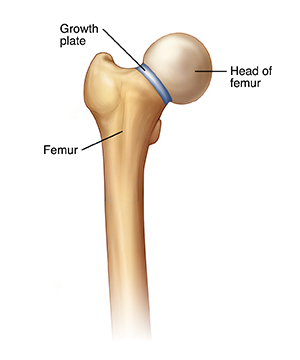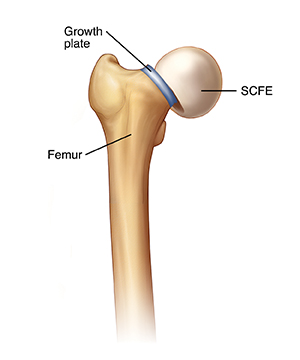When Your Child Has Slipped Capital Femoral Epiphysis (SCFE)
Your child has been diagnosed with a condition called slipped capital femoral epiphysis (SCFE). This means that the femoral head (the ball at the top of the thighbone) has slipped slightly off the thighbone. (It may help to picture a scoop of ice cream slipping off of a cone.) This problem can be very serious if not treated. Your child will likely be referred to an orthopedist, a doctor specializing in treating bone and joint problems, for evaluation and treatment.


What are the causes of slipped capital femoral epiphysis?
In some cases, SCFE occurs suddenly due to an injury or trauma. In other cases, it develops slowly over time due to an underlying problem. In many cases, the cause of SCFE is not known. Risk factors include:
-
Being between ages 8 and 15
-
Being a boy (more boys than girls have this condition)
-
Being African American
-
Being overweight
-
Having a problem with the thyroid gland
-
Taking certain medicines (such as oral steroids or growth hormones)
-
Family history of SCFE
What are the symptoms of slipped capital femoral epiphysis?
Symptoms of SCFE depend on severity and include:
-
Walking with a limp
-
Pain in the hip that may get worse with activity
-
Complaints that the hip feels like it’s “giving way”
-
Walking with the leg turned outward
-
Pain in the knee or thigh (in severe cases, the child may not be able to bear weight)
How is slipped capital femoral epiphysis diagnosed?
SCFE is often diagnosed by examining the child and watching them walk. An imaging test such as an X-ray is done to confirm the diagnosis. In some cases, additional imaging studies such as an MRI may be needed. Other tests may be done to check for an underlying problem (such as a thyroid problem) that could cause the SCFE.
How is slipped capital femoral epiphysis treated?
Treating SCFE is considered urgent because further slipping could damage the hip joint. To prevent further slipping, the child may be admitted to the hospital right away for surgery. Or the child may be instructed to use crutches and not put any weight on the leg until the SCFE can be fixed. Surgery is often done within 1 or 2 days of diagnosis. During the surgery, the surgeon puts a steel screw through the thigh bone into the femoral head. This screw holds the femoral head firmly in place.
What happens after surgery?
-
After surgery to fix a SCFE, the child will need to walk with crutches for 6 to 8 weeks.
-
The child may be referred to a physical therapist for treatment during recovery.
-
Follow-up is vital every 3 to 4 months for the next several years to recheck the treated hip.
-
In a child with SCFE in 1 hip, the other hip may be at increased risk of slipping. This is even more of a risk if an underlying problem led to the SCFE, or if the child is younger than age 10. In these cases, the surgeon may advise pinning the other hip along with the slipped hip. This prevents problems in the future.
What are the long-term concerns?
-
With treatment, SCFE often has a good outcome, especially if treated early. Your child’s doctor can tell you more.
-
Even after treatment, a child with SCFE is more likely to have arthritis in that hip as an adult.
-
In rare cases, even with treatment, the hip joint can still have problems. This is more likely if the growth plate was injured by the slip. The growth plate is a soft part of a long bone that allows the bone to grow as the child grows. Disruption of the blood supply to the femoral head during the slip may also lead to problems. Problems are more likely with severe SCFE. Catching these problems early is one reason why it's vital to continue to follow up with the surgeon as your child grows.